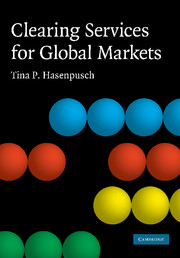 Clearing Services for Global Markets
Clearing Services for Global Markets Book contents
- Frontmatter
- Contents
- List of figures
- List of abbreviations
- Acknowledgements
- Foreword
- 1 Introduction
- 2 Setting the stage – definitions and industry setting
- 3 Defining the core issues – efficiency and network strategies
- 4 Collecting empirical insights – introduction to the empirical study
- 5 Analysing costs of derivatives clearing – transaction cost studies
- 6 Exploring theoretical basics – scale effects in clearing
- 7 What theory reveals – framework for efficiency analysis of network strategies
- 8 Checking theory against reality – case studies of network strategies
- 9 Quantifying the efficiency impact – European network strategies
- 10 Introducing the future network economy – development of the clearing industry
- 11 Summary, discussion and recommendations for future research
- Appendices
- Bibliography
- Index
10 - Introducing the future network economy – development of the clearing industry
Published online by Cambridge University Press: 19 January 2010
- Frontmatter
- Contents
- List of figures
- List of abbreviations
- Acknowledgements
- Foreword
- 1 Introduction
- 2 Setting the stage – definitions and industry setting
- 3 Defining the core issues – efficiency and network strategies
- 4 Collecting empirical insights – introduction to the empirical study
- 5 Analysing costs of derivatives clearing – transaction cost studies
- 6 Exploring theoretical basics – scale effects in clearing
- 7 What theory reveals – framework for efficiency analysis of network strategies
- 8 Checking theory against reality – case studies of network strategies
- 9 Quantifying the efficiency impact – European network strategies
- 10 Introducing the future network economy – development of the clearing industry
- 11 Summary, discussion and recommendations for future research
- Appendices
- Bibliography
- Index
Summary
The previous chapters served to provide conclusions on the efficiency impact of various network strategies within the European clearing industry. Based on these findings, this chapter identifies the most preferable future clearing industry structure and delivers recommendations for the industry's future development.
The following sections summarise and build on the insights obtained from the previous chapters to create an outlook on the future development of the European clearing industry (section 10.1), followed by an application of the research results to European clearing with regard to its global context (section 10.2). The chapter closes by summarising these findings (section 10.3).
Future development of the European clearing industry
We want dynamic, integrated capital markets in the EU – not segmented ones. And we are determined to achieve them. For all our customers, investors and companies. And to strengthen the European economy.
This study's objective was to identify the network strategy best suited to increase the efficiency of European clearing. In line with the above-quoted claim by Commissioner Charlie McCreevy (European Commission), it is considered to be a prerequisite that such an efficiency increase benefit all clearing members. Therefore, network strategies that favour some while penalising others (such as the Single CCP) are not regarded as viable scenarios.
In keeping with the Commission's vision to further European market integration, a recommendation for the future development of European derivatives clearing is formulated (section 10.1.1). The findings on derivatives clearing are then applied to European cash equities clearing (section 10.1.2).
- Type
- Chapter
- Information
- Clearing Services for Global MarketsA Framework for the Future Development of the Clearing Industry, pp. 406 - 427Publisher: Cambridge University PressPrint publication year: 2009


